Hello everyone! I've been lurking at this site for years and finally made an account to get feedback on my designs for our new homestead.


Hopefully these images piqued some interest. Some background:
We are in eastern TN, zone 6b. Our land is hilly, surrounded by a body of water. We are fully off-grid. The image shows a little over a hundred acres, but the lowest 3 contour lines are controlled by the state to preserve the water. The amount of land covered by pastures/orchards in the first picture is about 28 acres.Our main goals are to become self sustainable, and ideally be able to provide a stress-free place for family should they desire. We don't plan on making money or selling anything from the land. We will be onsite and have a lot of time available to work the land; we have much more land than we could realistically work though so we are ok to make tradeoffs that take more space but require less input from us.Right now the land is almost completely wooded. We believe the hilltops were pasture around 90 years ago, and some logging happened maybe 50 to 80 years ago. We have mostly oak, beech, maple, poplar, eastern red cedar and some pine, with a few fun individuals like pawpaw, sassafras, walnut, etc.We are trying to create the homestead so it does not require any -cides or heavy machinery, and avoiding as much plastics, toxins, GMO, etc as possible. We plan on following all the applicable permaculture principles, cover crops, rotations, natural predators, wildlife areas, companion planting, etc.
Right now the only part of the plan set in stone is the housesite which is currently under construction. I'm hoping that I can get feedback from this forum as to how practical the rest of my plans are, or any suggestions for improvement. While we have read information on the topic for years and years and have experience at others' homesteads, this is our first experience designing our own. Explaining the labels on the first image, starting in the middle of the north hill and expanding outward:
A large pasture on the north hill that we will rotationally graze with electric fencing. Also a smaller bull/quarantine pasture on the north side. I want to leave enough medium sized trees to provide shade/shelter in each rotation. I'm hoping to emulate this guys setup: Grass Fed SolutionsA swale running about 270 degrees around the outside of the pasture fence to soak in water for the orchards surrounding themOrchards below the swale on the land thats too steep for pasture. Planning on growing a wide variety of most types of fruit/nut trees that can grow in our area.A green access road belting the orchards.At the southwest end of the swale, several small gravel beds/ponds planted with riparian species to filter the water before it drains to a series of dammed ponds. We are planning on piping our greywater from the house to these gravel beds as well. Is a windpowered pump circulating water from the lower dam up to the top realistic, or is that too much height to cover?Below the biggest pond, we are planning on putting Chinampas on the low lying usually wet area. I really like the idea of Chinampas, but have seen very little real Chinampa implementation outside of their native Mexico area. Are there people who actually build "real" Chinampas, or does everyone saying they are doing Chinampas really mean just ponds with a lot of edges? Will Tilapia survive winters here, or do I need to look at more coldhardy fish? Would love to see real life examples linked (but hopefully not dominate this thread).Also planning on veggie/herb gardens, but right now I'm trying to stay focused on first building the systems that will take the most time/labor to mature.Outside of this more heavily worked area, we will leave the rest as forest to supply timber and firewood and feed the wildlife.
I hope this is enough information to start getting some ideas. Right now I'm not very worried about specifics but would love to hear general impressions on the overall design. Is my swale in the wrong place? Are my water features ludicrously over/under sized? Am I missing some crucial features? What would you do differently if you were developing this land for yourself?
Thank you!
I made this map with QGIS and publicly available LIDAR data. Its been very helpful to see hidden features and visualize the plan.










